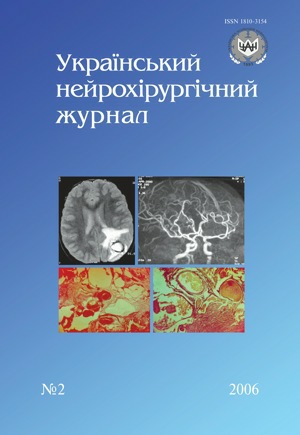Neurosurgical aspects of wake-up anaesthesia apply
DOI:
https://doi.org/10.25305/unj.126792Keywords:
tumor lesion of functionally important regions of the brain, surgical technique, indications, contraindications, wake-up anesthesiaAbstract
The study, that involved 26 cases of brain tumors, localized mainly at the functionally significant brain areas, has shown that wake-up anaesthesia is a progressive method at patient, undergoing neurosurgical treatment. The results of patients with glial tumors surgical treatment with wake-up anaesthesia applying during operation, depend on tumor size, it’s blood supply. Also the preoperative status of patients was analyzed. At 20 patients treatment positive results were reached: in case of total tumor removing around perifocal area the neurological deficit was minimized or was not expressed. In 6 patients neurological disorders were equal to preoperative level. A wake-up anaesthesia can be used successfully at patients with tumors of functionally significant brain areas.
References
Добродеев А.С., Салалыкин В.И., Тенедиева В. Д. Локорегионарная анестезия как компонент анестезиологического обеспечения при нейрохирургических вмешательствах на головном мозге // Материалы III съезда нейрохирургов России. — М., 2002. — С.408–409.
Дуус П. Топический диагноз в неврологии. Физиология. Клиника. — М.: Вазар-Ферро, 1996. — 324 с.
Зозуля Ю.А., Розуменко В.Д., Лисяный Н.И. Проблемы современной нейроонкологии // Журн. АМН України. — 1999. — Т.5, №3. — С.426–441.
Лубнин А.Ю., Салалыкин В.И., Цейтлин А.М. и др. Анестезиологическое обеспечение при удалении объемных образований из функционально важных зон больших полушарий головного мозга — краниотомия в сознании // Нейрохирургия. — М., 2000.
Малишева Т.А. Гістотопографічні особливості гліальних пухлин лобово-скроневої ділянки // Бюл. УАН. — 1998. — №5. — С.146–147.
Малишева Т.А. Мікрохірургічна анатомія гліом лобово-скроневої ділянки головного мозку // Бюл. УАН. — 1998. — №7. — С.33–35.
Острейко Л.М., Хилько В.А. Возможности интраоперационного нейрофизиологического мониторинга в оценке функционального состояния головного мозга при выполнении сложных нейрохирургических операций // Материалы III съезда нейрохирургов России. — М., 2002. — С.138.
Розуменко В.Д. Эпидемиология опухолей головного мозга: статистические факторы //Укр. нейpoxipypг. журн. — 2002. — №3. — С.47–48.
Шамаев M.I., Малишева Т.А. Топографоанатомічні та гістобіологічні особливості гліом лобово-скроневої ділянки головного мозку // Бюл. УАН. — 1999. — №1. — С.5–9.
Kurimoto M., Asahi T., Shibata T. et al. Safe removal of glioblastoma near the angular gyrus by awake surgery preserving calculation ability-case report // Neurol. Med. Chir. (Tokyo). — 2006. — V.46, N1. — P.46–50.
Sarang A., Dinsmore J. Anaesthesia for awake craniotomy-evolution of a technique that facilitates awake neurological testing // Br. J. Anaesth. — 2003. — V.90, N2. — P.161–165.
Downloads
How to Cite
Issue
Section
License
Copyright (c) 2006 S. A. Usatov, V. N. Shopin, Hatem Zalloum

This work is licensed under a Creative Commons Attribution 4.0 International License.
Ukrainian Neurosurgical Journal abides by the CREATIVE COMMONS copyright rights and permissions for open access journals.
Authors, who are published in this Journal, agree to the following conditions:
1. The authors reserve the right to authorship of the work and pass the first publication right of this work to the Journal under the terms of Creative Commons Attribution License, which allows others to freely distribute the published research with the obligatory reference to the authors of the original work and the first publication of the work in this Journal.
2. The authors have the right to conclude separate supplement agreements that relate to non-exclusive work distribution in the form of which it has been published by the Journal (for example, to upload the work to the online storage of the Journal or publish it as part of a monograph), provided that the reference to the first publication of the work in this Journal is included.









